
The ASW 20 is an FAI 15 metre Class glider designed by Gerhard Waibel and built by Alexander Schleicher GmbH & Co. Its fuselage is nearly identical to that of the ASW 19, mated to newly designed flapped wings for the 15 metre Class. The prototype first flew in 1977. It proved to be a highly successful glider, winning several World Championships, and was still being flown at this level up to 1995. Developments along its production life included winglets, pneumatic turbulators, and wingtip extensions. It remained in production until 1990, when it was superseded by the ASW 27. 765 were built by Schleicher and a further 140 were made under license by Centrair in France.

The Schempp-Hirth Cirrus is an Open Class glider built by Schempp-Hirth between 1967 and 1971 and by VTC until 1977. It was replaced by the Nimbus 2.

The Schempp-Hirth Nimbus-2 is an Open Class glider built by Schempp-Hirth during the 1970s. The Nimbus-2 first flew in April 1971 and a total of over 240 examples of all subtypes have been built until the beginning of the 1980s. It replaced the Schempp-Hirth Cirrus.
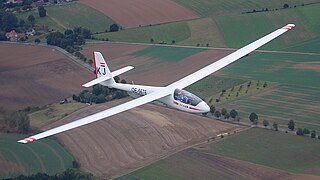
The Schleicher ASW 15 is a single-seat sailplane designed in 1968 by Gerhard Waibel and manufactured by Alexander Schleicher GmbH & Co. The ASW 15 has shoulder-mounted wings and an all-flying tailplane, with its single tow-release placement a compromise between winching and aerotowing. The later ASW 15B had several improvements, including a tow-release placed on the plane of symmetry, an 11 cm taller rudder, a slightly larger main wheel, and the provision of a 90-litre water ballast system.
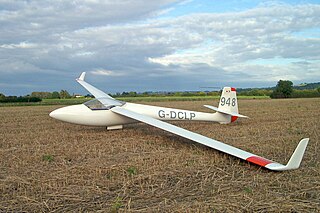
The Glasflügel 201 Standard Libelle is an early composite Standard Class single-seat sailplane produced by Glasflügel from 1967.

The ASW 19 is a single-seat glider built by Alexander Schleicher GmbH & Co, first flying in 1975. It was originally designed as a Standard Class glider, but now mainly competes in the Club Class. The ASW 19 is known for its pleasant handling and some clubs use it as a training glider. It was succeeded by the all-new Schleicher ASW 24.

The Glasflügel H-301 Libelle is an early composite single-seat sailplane produced by Glasflügel from 1964 to 1969. The H-301 had camber-changing wing flaps so was required to compete in the Open Class because the Standard Class excluded wing flaps. It was often known as the Open Class Libelle.
The Schleicher ASW 17 is a single-seat Open Class sailplane that was built by the German manufacturer Alexander Schleicher GmbH & Co and first flew in 1971. It replaced the ASW 12, and was replaced in 1981 by the ASW 22.
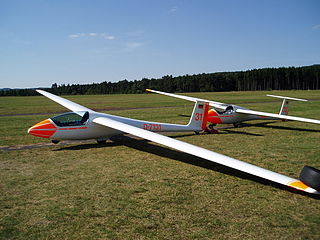
The Schleicher ASK 23 is a single-seat Club Class sailplane that was built by the German manufacturer Alexander Schleicher GmbH & Co.
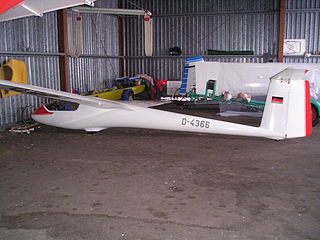
The Bölkow Phoebus is a glass fibre composite competition sailplane, designed and produced in Germany in the 1960s. Large numbers were built, achieving success at some national contests, and many remain active.

The Scheibe SF 34 Delphin is a two-seat sailplane that was produced by Scheibe in Germany in the late 1970s and 1980s. Designed by Wolf Hoffmann and originally designated the SF H34, it was Scheibe's first unpowered aircraft of composite construction.
Akaflieg Darmstadt is one of approximately twenty aviation groups attached to German universities. Akaflieg is an abbreviation for Akademische Fliegergruppe, an academic group of students and faculty from a German University.
The Monaghan Osprey is an American mid-wing, single-seat, T-tailed, FAI Standard Class glider that was designed and constructed by Richard C. Monaghan of Pearblossom, California.
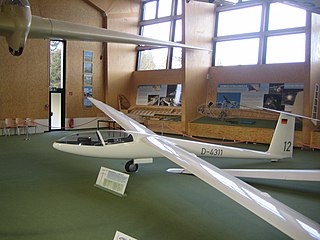
The Akaflieg Darmstadt D-36 Circe is a single seat, high performance sailplane designed and built in Germany in the mid-1960s, one of the early "glass ships". It was the winner at the German National Championships in 1964 and came second in the World Championships the following year.
The Akaflieg Darmstadt D-40 is an experimental variable geometry single seat sailplane, fitted with almost full span, camber changing flaps for optimum aerodynamics in weak thermals and integrated into the wing so as to minimise flap tip drag. One flew successfully but the D-40, like other variable geometry sailplanes, was not commercialised.
The Akaflieg Braunschweig SB-11 is an experimental, single seat, variable geometry sailplane designed by aeronautical students in Germany. It won the 15 m span class at the World Gliding Championships of 1978 but its advances over the best, more conventional, opposition were not sufficient to lead to widespread imitation.
The Akaflieg Darmstadt D-39 was a single-seat motor glider derived from the D-38 sailplane. Built in Germany in the late 1970s, it was not intended for production and only one was constructed.
The FVA-20 F. B. Schmetz was a single seat, Standard Class sailplane, built as a one-off aircraft, to explore the application of glass fibre to glider construction. Built over a long period, it finally flew in late 1979.

The Mistral-C was one of the first gliders, designed in 1974 to the then new Club Class rules. It was based on the Strauber Mistral, a Standard Class glider flown a year earlier, but with a new wing and built from newer composite materials. Both types were designed and constructed in Germany. More than 75 Mistral-Cs were produced.
The Bertoni Altinger AB-1 Superalbatros is a high-performance sailplane designed and built in Argentina in the 1950s and 1960s.












